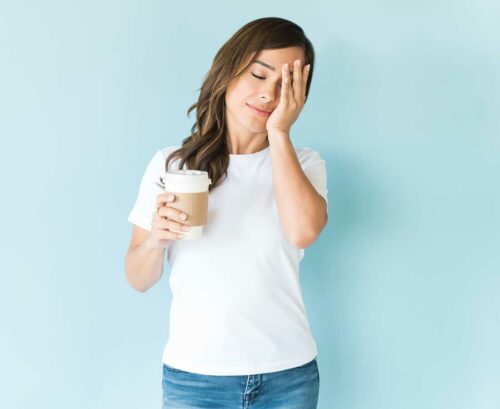
A lack of sleep isn’t the only reason so many of us are tired… all the time. If you feel like you’re regularly running on empty, discover what to eat to turn things around and get your energy back.
With millions of us visiting the GP for fatigue each year, research reveals our national ‘human energy’ crisis is reaching a tipping point. On average, women only feel like they have the energy they need on just four days out of every 10 days. Men don’t fare much better, reporting they only have sufficient energy to get through their day 50 per cent of the time. So what’s behind the slump?
Sleepless nights
One in three of us don’t get the recommended seven to eight hours of sleep a night, and 60 per cent of us suffer from at least one sleep problem, such as difficulty falling or staying asleep, on three or more nights a week. This ‘epidemic of sleep deprivation’ has been identified as one of the main reasons so many of us don’t have enough energy, day to day. But it’s not the only explanation.
Get your energy back!
Unexplained tiredness can also be a result of lifestyle choices and a poor diet, or an underlying health issue. Read on to discover six more factors that are capable of zapping your energy levels, how to know if your health is at risk, and what you can do to get the pep back into your step.
Energy zapper #1: Social jetlag
This occurs when your daily routine doesn’t align with your natural body clock or sleep chronotype, which is what dictates whether you’re a ‘night owl’ or a ‘morning lark’. Affecting around one third of us, research shows that social jetlag not only plays a big part in the nation’s lack of sleep, it results in routinely waking up tired.
Other symptoms:
Regularly oversleeping in the morning, being late for work and feeling like you should have taken a sick day instead of going into work.
What you can do
Altering your daily schedule to suit your sleep chronotype isn’t always an option, so try to get smarter about sleep. Set yourself up for a good night’s sleep by eating dinner no later than two hours before bedtime, don’t use electronic devices with blue-light emitting screens an hour before you want to go to sleep, and don’t lie in for too long on weekends. Why? Because research reveals long lie-ins make social jetlag worse. Instead, experts recommend going to sleep just a little earlier and getting up just a little later on weekends if you need to catch up on sleep.
Energy zapper #2: Underactive thyroid
Also known as hypothyroidism, the most common symptom of this condition is fatigue or low energy levels. It affects up to 10 per cent of women, but becomes more common as we age, with a quarter of women over 65 experiencing it. Men can also develop hypothyroidism.
Other symptoms:
Unexplained weight gain, dry skin, hair loss, constipation, feeling the cold more than usual and trouble concentrating.
What you can do
It’s important to see your doctor to confirm a diagnosis of hypothyroidism via a blood test. Treatment varies depending on the cause of the condition, but if a contributing factor is iodine deficiency, this can be improved by increasing your intake of iodine-rich foods, such as eggs, seafood and dairy products. Commercial bread products in some countries are also fortified with iodine.
Energy zapper #3: Long COVID
Thought to affect at least one in 10 people who test positive to COVID-19, long COVID is defined by symptoms that remain or even change, months after the initial infection. There are more than 200 symptoms associated with long COVID, but fatigue has been identified as the most common and debilitating one.
Other symptoms:
Brain fog, joint and muscle pain, changes to taste and smell, and shortness of breath.
What you can do
No specific treatment is currently available for long COVID or the long-term fatigue it causes, but research shows that simply seeking advice from a GP, who takes long COVID seriously, can help. Learning a technique called ‘pacing’, which helps you operate within your ‘energy envelope’, may also be useful. To learn more about fatigue, how to live with it and pacing, visit emerge.org.au
Energy zapper #4: Iron deficiency
Globally, around 29 per cent of women have anaemia, where red blood cell levels fall so low, the blood can’t deliver enough oxygen to the body’s cells. And iron deficiency — without anaemia — is thought to affect even more women (up to one in two). Feeling tired and run down is often the first sign of too-low iron levels.
Other symptoms:
Breathlessness, poor memory and concentration, getting infections regularly and finding it difficult to exercise, depending on the severity of your iron deficiency.
What you can do
Bump up your intake of iron-rich foods, especially if you’re vegetarian or you don’t eat a wide range of fresh fruit and vegetables. Animal-based foods (red meat, eggs and seafood) as well as plant-based ones (whole grains, legumes, nuts, seeds and dark, leafy green vegetables) are both good sources of iron, but it’s the iron from animal-based sources that is more easily absorbed. More severe cases of iron deficiency are treated with iron supplements, but always see your GP for an official diagnosis before you start taking iron supplements
Energy zapper #5: Low vitamin D levels
One in three of us lack sufficient vitamin D. Since sunshine is the best source, the risk of deficiency increases during winter. Thanks to the way vitamin D helps the body absorb calcium, a vitamin D deficiency is also a well-known risk factor for osteoporosis (or brittle bones) in the long term. In the short term, low vitamin D levels cause fatigue.
Other symptoms:
Bone pain, mood swings, muscle aches and cramps or weakness.
What you can do
How much sun you need varies on your skin type and the time of year. When UV rays are strongest in summer, a few minutes is usually enough. Always use sun protection if the UV index is three or above. It’s difficult to obtain enough vitamin D through diet alone, but eating foods that are good sources of vitamin D (oily fish, eggs and fortified milks) help. Foods like mushrooms can even absorb vitamin D if left out in the midday sun for 15 minutes.
Energy zapper #6: Menopause
The cessation of monthly periods for women occurs, on average, at the age of 51. Symptoms can begin years before, during what is known as perimenopause, and can last for some time after menopause, too. Eight out of 10 women experience menopausal symptoms, such as increased tiredness and difficulty sleeping.
Other symptoms:
Hot flushes, night sweats, itchy skin, headaches, aches and pains, weight gain, forgetfulness, difficulty concentrating and feeling anxious and irritable.
What you can do
Talk to your GP about treatments such as HRT (hormone replacement therapy), also known as MHT (menopausal hormone therapy). Research suggests that eating half a cup of edamame beans a day, as part of a healthy diet, can reduce hot flushes and night sweats by up to 84 per cent. This, in turn, can help to improve sleep quality.
5 ways to boost your mood and energy with food
Once you’ve ruled out underlying health conditions, try these five diet-related ideas to feel revitalised.
1. Boost your fibre intake
People who ate more fibre over a four-week period had a 10 per cent reduction in fatigue, a Welsh study found. High-fibre foods include fruit and veg, wholegrain cereal products and nuts and seeds. A breakfast of wholemeal toast is an easy way to bump up your fibre intake.
2. Snack on pumpkin seeds
They’re rich in magnesium, a mineral that can cause fatigue when it’s lacking. Around one in three women and two in five men eating a Western diet don’t consume enough magnesium. A 30g serve of pumpkin seeds contains half of women’s daily magnesium requirements and one third of men’s, so boosting your intake of this important mineral can be easy.
3. Drink lots of water
Even mild hydration affects energy levels. In fact, if you need a quick pick-me-up, try drinking three glasses of water in a row. When a study group did this, UK researchers found the study participants reported an increase in mental energy and faster brain reaction times afterwards.
4. Eat more kiwifruit
They provide a big hit of vitamin C, which is involved in energy production. Putting the theory to the test, a New Zealand study found people who ate two kiwifruit a day for six weeks had less fatigue and more energy than those eating just half a kiwifruit a day.
5. Enjoy dark chocolate
If made from 85 per cent cocoa, dark chocolate can help fight fatigue. This is thought to be due to the antioxidants in dark chocolate positively influencing at least three brain chemicals linked to mood, sleep and alertness.
Article sources and references
- Australasian Menopause Society. 2019. What is menopausal hormone therapy (MHT) and is it safe? Accessed April 2022.https://www.menopause.org.au/health-info/fact-sheets/what-is-menopausal-hormone-therapy-mht-and-is-it-safe
- Better Health Channel. 2011. Thyroid — hypothyroidism. Accessed April 2022https://www.betterhealth.vic.gov.au/health/conditionsandtreatments/thyroid-hypothyroidism
- Better Health Channel. 2015. Fatigue. Accessed April 2022.https://www.betterhealth.vic.gov.au/health/conditionsandtreatments/fatigue
- Better Health Channel. 2022. Iron and iron deficiency. Accessed April 2022. Cancer Council. 2008.https://www.betterhealth.vic.gov.au/health/conditionsandtreatments/iron
- How much sun is enough? Accessed April 2022.https://www.rch.org.au/uploadedFiles/Main/Content/immigranthealth/CCA_Vitamin_D_brochure.pdf
- Cleveland Clinic. 2021. Perimenopause. Accessed April 2022.https://my.clevelandclinic.org/health/diseases/21608-perimenopause
- Davis et al. 2021. Characterizing long COVID in an international cohort: 7 months of symptoms and their impact. eClinicalMedicine. 38: 101019.https://pubmed.ncbi.nlm.nih.gov/34308300/
www.healthyfood.com










